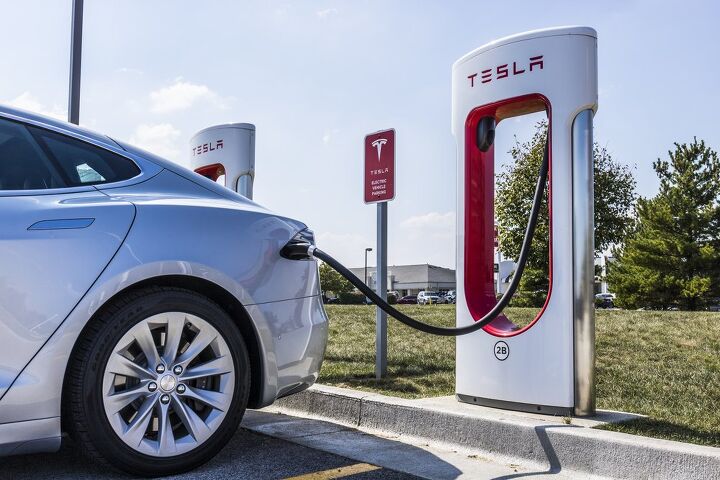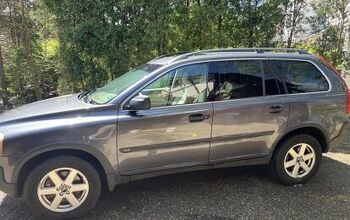White House: Tesla to Open Charging Network Under Federal Program

On Wednesday, the Biden administration announced that Tesla will begin opening up portions of its proprietary charging network to all electric vehicles by the end of 2024. While the move could undermine one of the most desirable aspects of owning a Tesla, by forcing owners to share what’s likely to be the largest and most reliable charging network in the country, the EV purveyor isn’t coming away empty-handed. The arrangement comes under a new $7.5-billion federal program to electrify the nation's highways stemming from the $1-trillion infrastructure package signed in 2021.
With long-range trips serving as the Achilles' heel for most electric vehicles, the Biden administration has set a goal to expand the national charging network to ensure EVs can make cross-country journeys. While combustion vehicles will still be more convenient whenever there’s road-tripping to be done, primarily due to disparities between charging and fueling times, simply having more places to plug in is assumed to help increase EV adoption rates – something the White House says is necessary to address climate change.
The plan will make at least 7,500 chargers from Tesla’s Supercharger and Destination Charger networks available to non-Tesla EVs by the end of 2024.
General Motors, EVgo, Pilot, Hertz, and a slew of other companies also have similarly agreed to expand their networks by thousands of public charging ports in the next two years. The Wall Street Journal reported this will stem from a mix of private funds and federal spending tied to that massive infrastructure package. But that’s less-exciting news because Tesla basically has the only comprehensive charging network in the U.S. that isn’t constantly being chided by users for boasting excessive downtime and subpar maintenance.
While Tesla hasn’t said much on the matter just yet, the Biden administration has explained that Tesla will begin opening up existing sites while creating new ones at hotels, restaurants, and other locations. This is to take place in both urban and rural areas, with additional locations being selected along major highways to ensure vehicles can still recoup energy between stops. According to Politico, officials have asserted that all EV drivers will be able to access these stations using the Tesla app or website.
In exchange, Tesla will become eligible to qualify for federal money under the administration’s plan to build a national network of 500,000 chargers as part of the aforementioned infrastructure deal that turned out to be more of a climate funding package. There’s likewise been speculation that the deal would help alleviate some of the ongoing tension between the automaker and the Biden administration.
Tesla already had plans to triple its already massive domestic network and has already opened it up to the public in several nations that aren’t the United States. Considering the limited scope of this arrangement (the company has roughly 17,000 fast chargers in the U.S.), there’s been speculation that Tesla’s lobbying efforts are starting to rival that of legacy automakers. Tesla also seemed to get its way in terms of nullifying White House proposals that would have tied EV tax credits to unionized labor and has numerous vehicles occupying the sweet spot of the scheme’s pricing caps.
Administration officials have also begun rolling out new minimum standards that all chargers will have to meet to receive their share of the multi-billion-dollar electric vehicle charging grants. This is something they’ve been discussing for some time and has been seen as an obstacle by most people tracking EV adoption. But concerns have likewise been launched that blanket standardization could unintentionally slow the development of new charging technologies. On the counterpoint, requiring stations to meet minimum downtime quotas could encourage companies to improve maintenance and thereby increase customer satisfaction.
From Politico:
The new rules also require that chargers must reliably work 97 percent of the time, a bid to address growing complaints among drivers that charging equipment is often broken. Motorists must also be able to operate and pay for them using a universal app and account, no matter which company operates the station. The chargers Tesla opens up to the public will [also] be accessible using third-party apps, officials said.
“No matter what EV you drive, we want to make sure that you will be able to plug in, know the price that you’re going to be paying, and charge up with a predictable and user-friendly experience, just as when you are filling up with gas today,” Transportation Secretary Pete Buttigieg told reporters before the announcement.
DOT has already approved plans from all 50 states plus D.C. and Puerto Rico to deploy $1.5 billion of the [National Electric Vehicle Infrastructure] funds, and Wednesday’s standards give states the information they need to begin ordering the chargers, Buttigieg said.
DOT also finished its “Buy America” waiver for the NEVI program, which the Federal Highway Administration initially proposed in August. Companies and some state DOTs had asked the agency to relax some requirements that charger parts be manufactured domestically as the industry tries to keep up with soaring electric vehicle demand.
Under the rule finished Wednesday, final assembly for all chargers funded by NEVI must occur in the U.S., effective immediately. In addition, by July 2024, 55 percent of the components of the chargers must be manufactured domestically. The department also added an interim step that requires 25 percent of the components be manufactured in the U.S. by this coming July.
Billions more have been set aside for a handful of projects designed to expand the charging and clean hydrogen refueling infrastructure for medium- and heavy-duty vehicles. The Joint Office of Energy and Transportation has also announced it’s preparing a $47-million funding opportunity for research and development into improving the reliability and general accessibility of EV chargers.
“That will also help industry implement key parts of the new standards that the agencies are announcing,” Energy Secretary Jennifer Granholm told the press. “All of these actions across the administration are going to be key to unlocking much more widespread EV adoption.”
That’s the plan. All of the funding basically exists just to put us on the same footing as Europe in terms of EV adoption rates while ensuring that U.S. companies are producing a meaningful amount of the relevant technologies. And, if it doesn’t work, at least those companies received billions of dollars in taxpayer money to test the theory.
[Image: Jonathan Weiss/Shutterstock]
Become a TTAC insider. Get the latest news, features, TTAC takes, and everything else that gets to the truth about cars first by subscribing to our newsletter.

A staunch consumer advocate tracking industry trends and regulation. Before joining TTAC, Matt spent a decade working for marketing and research firms based in NYC. Clients included several of the world’s largest automakers, global tire brands, and aftermarket part suppliers. Dissatisfied with the corporate world and resentful of having to wear suits everyday, he pivoted to writing about cars. Since then, that man has become an ardent supporter of the right-to-repair movement, been interviewed on the auto industry by national radio broadcasts, driven more rental cars than anyone ever should, participated in amateur rallying events, and received the requisite minimum training as sanctioned by the SCCA. Handy with a wrench, Matt grew up surrounded by Detroit auto workers and managed to get a pizza delivery job before he was legally eligible. He later found himself driving box trucks through Manhattan, guaranteeing future sympathy for actual truckers. He continues to conduct research pertaining to the automotive sector as an independent contractor and has since moved back to his native Michigan, closer to where the cars are born. A contrarian, Matt claims to prefer understeer — stating that front and all-wheel drive vehicles cater best to his driving style.
More by Matt Posky
Latest Car Reviews
Read moreLatest Product Reviews
Read moreRecent Comments
- Lou_BC Well, I'd be impressed if this was in a ZR2. LOL
- Lou_BC This is my shocked face 😲 Hope formatting doesn't fook this up LOL
- Lou_BC Junior? Would that be a Beta Romeo?
- Lou_BC Gotta fix that formatting problem. What a pile of bullsh!t. Are longer posts costing TTAC money? FOOK
- Lou_BC 1.Honda: 6,334,825 vehicles potentially affected2.Ford: 6,152,6143.Kia America: 3,110,4474.Chrysler: 2,732,3985.General Motors: 2,021,0336.Nissan North America: 1,804,4437.Mercedes-Benz USA: 478,1738.Volkswagen Group of America: 453,7639.BMW of North America: 340,24910.Daimler Trucks North America: 261,959


































Comments
Join the conversation
If Tesla was smart, they would offer the charging for a nominal cost but limit the rate to 5mi/hr.
If you wanted a faster charge, non tesla owners should pay through the nose. you want 75 mi/hr? That will cost you 10x more. 150 mi/hr? 20x more. Make a "quick" fillup cost hundreds of dollars.
So middle class taxpayers are subsidizing another billionaire. Shocked I say.